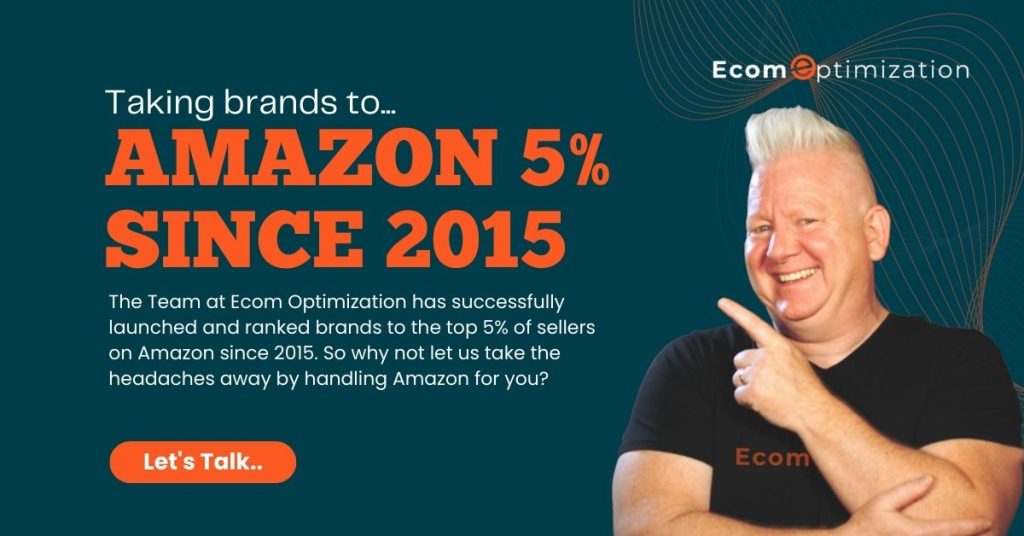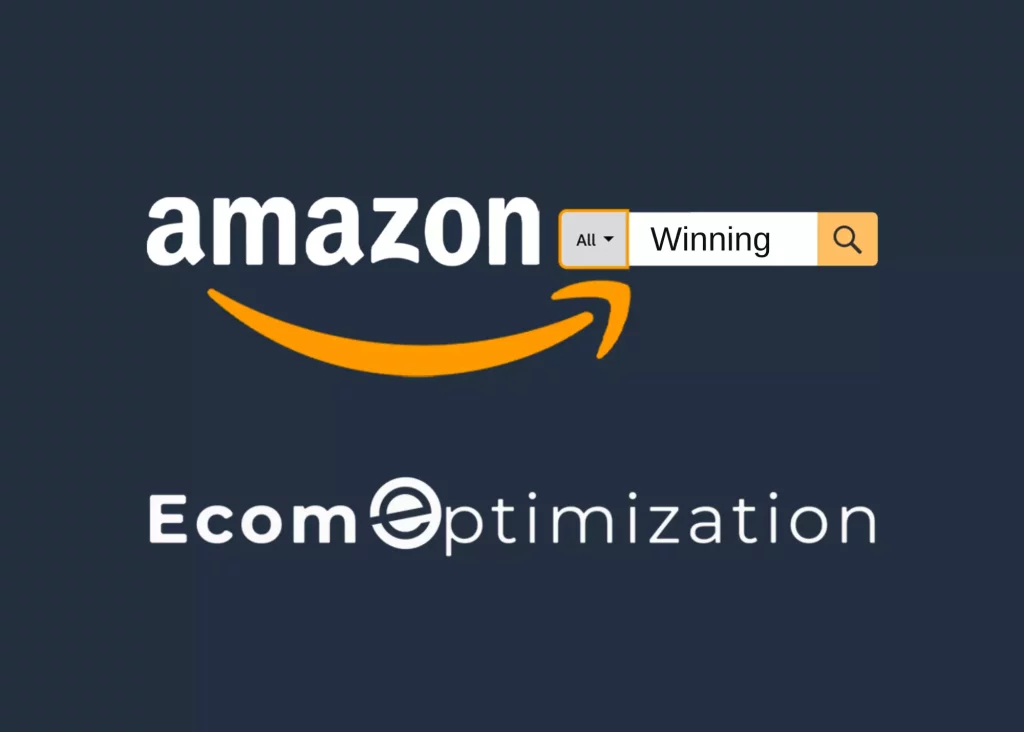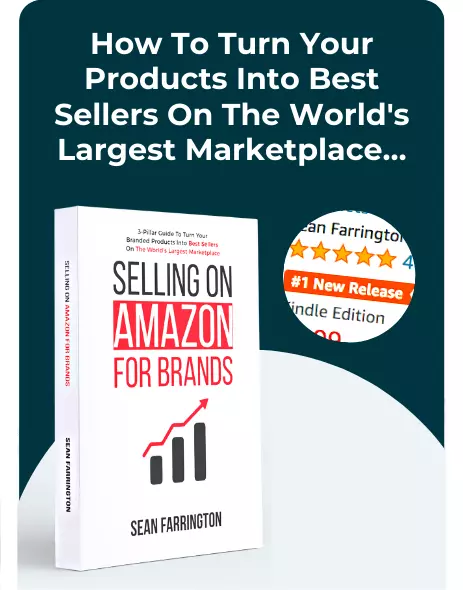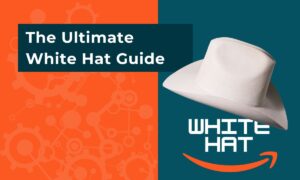WARNING: Shopify To Amazon Integration Fails (Read Before You Connect Amazon With Your Shopify Store)

While Shopify is a popular e-commerce platform that lets you set up online stores quickly, using a Shopify-Amazon Integration to sell on Amazon is usually a big mistake. In this blog post, we’ll share from experience why that is, and offer your next steps forward.
Jump To Section
Introduction
With its user-friendly interface, customizable design templates, and a wide range of features and integrations, a Shopify store is often considered a top choice for building and managing online stores. However, using a Shopify-Amazon integration to sell on Amazon is a different ballgame altogether.
Why?
Amazon is weird...
From the unique and specific rules, policies, and terms of service for a professional seller account, to the strange practices that sellers may encounter, selling on Amazon can sometimes be very confusing or challenging for sellers used to doing business as usual (or even business as a normal person would expect).
Amazon-Specific SEO:

From Keyword Density profiles based on top-selling products to product rankings based on the market value of each available keyword phrase, Amazon SEO is simply different than Google (or any other platform) and failure to set listings up with these considerations often leaves Founders and Executives confused by why their Amazon sales channel fails and their listings end up at the bottom of the search rankings pile. Sadly, no current Shopify-Amazon integration has the capability to optimize listings to this level of sophistication.
Amazon’s A10 Algorithm:
Amazon’s search algorithm is extremely complex and constantly evolving to maximize Amazon sales (something Google, Facebook, And others care nothing about). This sales-driven focus can significantly impact your product visibility and rankings.
Understanding and optimizing for Amazon’s algorithm requires specific strategies and techniques that are completely different from an online store, ore more specifically an active Shopify store. These requirements make Amazon “weird” in terms of search engine optimization (SEO) and product discoverability.
We’ll go over how to deal with this in this article.
Sales Conversions Equal Sucess:
Amazon is focused on how well listings ultimately convert to sales. Why? Because conversions are a key metric that determines the success and profitability of Amazon’s bottom line. As an e-commerce platform, Amazon’s main goal is to generate sales and generate revenue. Your sales conversion metrics are part of that goal.
Product Listing Requirements:
Amazon has very strict product listing requirements, including detailed product information, images, titles, and descriptions, which must meet specific guidelines (aka. Terms of Service).
Failure to comply with these requirements can result in listings being suppressed or removed, and can even cause Amazon account suspension. Also, quite recently, many silly mistakes will now require an appeal Amazon’s Seller Support to undo erroneous suppressions and to save Amazon Seller Central Accounts from suspension an deactivation.
Fulfillment Options:
Amazon offers various fulfillment options, including FBA (Fulfillment by Amazon), where Amazon handles storage, shipping, and customer service, and FBM (Fulfillment by Merchant), where sellers handle these aspects themselves. Understanding and choosing the right fulfillment option (and knowing when to use both) can be crucial for a seller’s success on Amazon.
Policies and Regulations:
Amazon has its own set of policies and regulations, including restrictions on certain products, prohibited actions, and intellectual property rights. Understanding and complying with these policies can be complex and may require specific knowledge and expertise, which can be considered “weird” compared to other platforms.
Based on the above points (and tons of past experience) Shopify store owners will often encounter challenges and potential regrets when setting up an Amazon professional seller account then simply connecting a Shopify-Amazon integration. This disappointment is due to the limited integration of Shopify to Amazon apps and a lack of Amazon-specific knowledge for optimizing Amazon as a sales channel.
Therefore, it is recommended that all Shopify store owners carefully consider these factors before choosing to connect via a Shopify-Amazon integration. Instead, explore alternative options that are specifically designed for optimizing Amazon as a profitable sales channel, and avoid potential frustrations with their Amazon sales channel.
What Does The Amazon A10 Algorithm Do?
The A10 algorithm is Amazon’s proprietary search algorithm that determines where your product listings will rank on the Amazon platform.
The factors that the A10 uses include product title, product description, customer reviews, sales velocity, pricing, and most importantly, sales conversions.
Understanding and optimizing for the A10 algorithm is crucial for sellers on Amazon as it can significantly impact the visibility and discoverability of their products. By optimizing product listings with relevant keywords, high-quality images, accurate product information, and positive customer reviews, sellers can improve their chances of ranking higher in search results and attracting more customers.
It’s important to note that the A10 algorithm is constantly evolving, and Amazon updates its algorithm often.
Therefore, to enjoy profitable Amazon listings, you need to stay updated on Amazon’s guidelines and best practices for optimizing your Amazon sales channel to align with the A10 algorithm’s requirements and improve your chances of success on Amazon’s platform.
Why Does Amazon Care About Listings That Ultimately Convert To Sales?

Amazon cares about listings that ultimately convert to sales because sales are key to the success and profitability of the Amazon platform. As an e-commerce platform, Amazon’s main goal is to facilitate sales that generate revenue.
When sellers list their products on Amazon, Amazon earns a percentage of the sales as a referral fee. Therefore, the more products you sell on Amazon, the more revenue Amazon generates.
Amazon’s A10 algorithm, which determines the visibility and rankings of products in search results, is designed to prioritize listings that are likely to convert to sales. Listings that have higher sales velocity, positive customer reviews, and emotionally persuasive product information are more likely to be ranked higher in search results and attract more customers, leading to increased sales on the platform.
By prioritizing listings that have a higher likelihood of converting to sales, Amazon aims to provide a better shopping experience for customers, encourage sellers to optimize their listings for conversion, and generate more revenue for the platform. Therefore, it is crucial for sellers on Amazon to focus on optimizing their product listings to improve their chances of converting sales and succeeding on the platform.
Why Do Amazon Shoppers Think Differently From Other Shoppers?

Amazon has a unique ecosystem with specific customer expectations that influence the way shoppers interact with the platform.
Amazon Prime: Amazon shoppers actually pay a premium for the privilege of shopping! Amazon Prime’s subscription-based service provides benefits such as free and fast shipping, access to streaming services, and exclusive deals.
Prime members tend to prioritize products that are eligible for Prime shipping, which can impact their purchasing decisions and expectations. This influences how Amazon shoppers evaluate products, shipping options, and pricing compared to shoppers on other platforms. Bottom line, Amazon shoppers are by and large premium shoppers
Customer reviews: Amazon places a strong emphasis on customer reviews, and reviews play a significant psychological role in influencing purchasing decisions on the platform.
Amazon shoppers may heavily rely on customer reviews to assess product quality, performance, and value for money. This causes different purchasing behaviors compared to shoppers on other platforms that may not prioritize customer reviews.
Product information: Amazon requires sellers to provide detailed and accurate product information, including product titles, descriptions, and images. Amazon shoppers heavily rely on this information to make informed purchasing decisions.
This requires an upscale online shopping experience compared to other platforms that may not have the same level of standardization.
Brand loyalty: Amazon has a dedicated ecosystem of shoppers compared to shoppers on other platforms. Amazon shoppers may be more open to trying new brands or yet demand a premium shopping experience due to factors such as convenience, and trust in the Amazon brand.
Search behavior: Amazon has a unique search algorithm (A10 algorithm) that determines the visibility and rankings of products in search results. Amazon shoppers have different search behaviors compared to shoppers on other platforms because searchers are actually in buying mode.
It’s essential for sellers to understand the unique characteristics of the Amazon platform and its shoppers to effectively market and sell their Shopify products on Amazon.
The bottom line, before you head to the Shopify app store in search of a multi-channel selling tool, please understand that no Shopify-Amazon integration can successfully negotiate all of the requirements to develop a successful Amazon sales channel like a trained and experienced Amazon specialist.
Why Do I Need An Amazon-Specific SEO Strategy?
Amazon’s A10 Algorithm:
Amazon has its own unique search algorithm called the A10, which determines the visibility and rankings of products in search results largely based on Sales Conversions.
Understanding and optimizing for the A10 algorithm is critical to improving the visibility of your products on Amazon and driving organic traffic to your Amazon listings. Ignoring or neglecting Amazon’s A10 algorithm will result in poor visibility, lower rankings, and reduced sales.
Competition on Amazon:
Amazon is a highly competitive marketplace with millions of sellers and products vying for shopper attention. Having a well-defined Amazon Marketing strategy can give you an edge over your competitors and help you stand out in the crowded marketplace.
Optimizing your Amazon listings for sales conversions and SEO can improve your rankings in Amazon search results, making it easier for shoppers to find and purchase your products.
Amazon Shopper Behavior:
Amazon shoppers have different search behaviors compared to shoppers on other platforms. They use specific search terms, filters, and criteria to find products on Amazon (including searching for Prime-exclusive listings).
Understanding and aligning with Amazon shopper behavior is crucial for optimizing your product listings and making them more appealing and relevant to Amazon shoppers. This requires careful research and analysis of Amazon-specific keywords and other elements that influence shopper behavior on Amazon.
Conversion Rate Optimization (CRO):
Amazon places a strong emphasis on listings that ultimately convert to sales. Higher conversion rates signal to Amazon that your products are relevant and appealing to shoppers, leading to improved rankings and visibility. Therefore, optimizing your product listings for conversion rate is essential for success on Amazon. This may involve optimizing product images, titles, bullet points, and other elements that influence shoppers to make a purchase.
Amazon’s Dynamic Marketplace: Amazon is a dynamic and ever-evolving marketplace, with changes in product rankings, customer preferences, and competitive landscape occurring frequently. Having an Amazon-specific SEO strategy allows you to adapt and optimize your listings in response to changes in the marketplace. This may involve regular monitoring of your product rankings, customer reviews, and competitor analysis to stay competitive and relevant in the Amazon ecosystem.
Therefore, it is highly recommended to develop and implement a custom-fitted Amazon-specific SEO strategy to maximize your chances of success on the Amazon platform.
How Does Amazon Handle Keywords Differently Than Google?
Keywords play a crucial role in Amazon product listing optimization for improving visibility in search results.
Amazon Is A Sales Channel
However, the intent of users when searching on Amazon is different from that on Google. Amazon shoppers are typically in a buying mode, searching for specific products with the intention to purchase.
In contrast, Google users may have different intentions such as seeking information, comparison shopping, or browsing. This means that the keywords and content that perform well on Google may not necessarily be effective on Amazon, and vice versa.
Amazon shoppers typically search for specific products or solutions to meet their needs, and therefore, the keywords used on Amazon are focused on product names, features, attributes, and use cases.
For example, if you are selling a “portable water bottle,” relevant keywords on Amazon might include “portable water bottle,” “leak-proof water bottle,” “BPA-free water bottle,” and so on.
Google Is For Search

On the other hand, Google keywords tend to be informational or research-based, as users often use Google to gather information, learn about topics, or solve problems.
Google keywords may include questions, phrases, or broad terms related to a topic or theme, and the intent behind the search may not always be purely transactional.
For example, if someone is looking for information on “how to stay hydrated during workouts,” they may use keywords like “best ways to stay hydrated during workouts,” “hydration tips for athletes,” or “hydration during exercise” on Google.
Understanding this difference in keyword usage between Amazon and Google is crucial for optimizing product listings on Amazon.
Relying solely on Google keywords will not yield the same results on Amazon, as the search behavior and purchase intent of Amazon shoppers are typically different from Google users.
Amazon keywords are geared towards buying activities, while Google keywords tend to be more informational or research-based.
Additionally, Amazon’s focus on sales performance and conversion rates contributes to fast-moving keyword trends as compared to Google.
Since Amazon places a higher emphasis on products that are generating sales and have positive customer reviews, if a product with specific keywords is generating sales and gaining positive reviews, that keyword may trend upward quicly, leading to a keyword that is not yet showing up on Google.
Furthermore, Amazon’s product catalog is more centralized and structured compared to the vast and diverse landscape of the internet that Google has to index. This may also contribute to faster keyword trends on Amazon.
This causes a mismatch between on-Amazon keywords and Google keywords.
This is why Amazon strategies and Google strategies are not interchangeable.
It is important to understand the unique characteristics of each platform and tailor your optimization strategies accordingly to achieve optimal results.
Simply applying a strategy that works on one platform to the other may not yield the desired outcomes.
Understanding this difference is essential for developing an effective SEO strategy on Amazon and maximizing the visibility and success of product listings on the platform.
Why Is Keyword Density So Important On Amazon?
Keyword density refers to the frequency of a particular keyword or phrase that appears in your Amazon product listing. It is an essential aspect of Amazon SEO as it determines how well your product will rank in search results.
By analyzing top-selling products, you can identify popular and relevant keywords that are commonly used by customers when searching for products similar to yours.
You need to understand that Amazon uses Keyword Density profiles as part of how the A10 Algorithm ranks new listings. Amazon creates Keyword Density profiles based on top-selling products (read: listings that create sales revenue for Amazon).
The A10 algorithm compares new product listings to the Keyword Density profile of top-selling, highest profitability listings.
If your new listing has a similar keyword density to top-selling products, Amazon will give your new listing a shot at the rankings because that Algorithm can smell the profit potential.
You can use keyword research tools to determine the Keyword Density of your listing. This data will help you understand which keywords are worth targeting and how frequently they should be included in your product description, title, bullet points, and backend search terms.
By optimizing your Amazon listings with high-quality and relevant keywords, you increase the chances of ranking higher in search results. However, it’s important not to overuse keywords as this could result in penalization from Amazon’s algorithm.
A balanced approach that considers both keyword density and relevance is crucial for achieving success on the platform.
This gets back to the fact that Amazon is an e-commerce platform where customers come to purchase products.
Therefore, Amazon’s primary focus is on driving sales and maximizing revenue. The success of Amazon’s business model relies heavily on the conversion of product listings into actual sales.
Amazon’s A10 algorithm, which ranks products in search results, takes into consideration any factor that proves profitability, from keyword density to the historical sales performance of a product as an important factor in determining its ranking.
This is why…
If You Can Focus On Only One Metric It Is Your Conversion Rate...
Higher sales conversions indicate that a product is relevant and appealing to customers, and Amazon rewards such products with higher visibility in search results and free traffic, leading to more sales opportunities.
Compared to other potential traffic sources, like Google or Facebook which focuses on connecting people and facilitating communication or helping with search, Amazon’s main objective is solely focused on driving sales.
For example, Facebook’s algorithm and advertising strategies are designed to prioritize engagement, reach, and audience targeting, rather than direct sales conversions. Likes, shares, comments, and other forms of engagement are considered important metrics on Facebook, as they indicate the level of audience interaction and interest in the content, rather than immediate sales conversions.
Amazon, being an e-commerce platform, places a higher emphasis on conversions as it directly impacts the sales and revenue of the platform.
This is why on Amazon, having high traffic or visibility alone is not enough to guarantee success. While driving traffic to your Amazon store and individual product listing is important, it is more critical to focus on conversion rate, which refers to the percentage of visitors who make a purchase after landing on your product page.
By and large, Amazon shoppers are searching to buy not to socialize or research. Therefore, it is essential to optimize your product listings to effectively convert shoppers into customers.
This includes using high-quality product images, writing emotionally compelling product descriptions, and showcasing positive customer reviews. All these factors contribute to creating a listing that appeals to Amazon shoppers and increases the likelihood of them making a purchase.
Simply relying on driving traffic to your product listing without focusing on conversion optimization will result in wasted efforts and poor sales performance which ultimately will tank your ranking on Amazon.
Conclusion
To succeed on Amazon, your product listing and Amazon Store must be converting machines that effectively persuade and convinces visitors to become customers, leading to higher sales and revenue for Amazon (and for you). Using the data from your Shopify store to link Shopify to your Amazon Listings Page will simply not turn Amazon into a profitable sales channel.
FAQs
Q: Can I use my Shopify account to sell on Amazon?
A: Yes, you can technically integrate Shopify to sell on Amazon, but it may not be the best move due to limited Amazon-Shopify integration, as wel as the lack of ability to integrate your Shopify store to meet the Amazon-specific features and requirements mentioned above.
Q: What are the risks of using Shopify to sell on Amazon?
A: The risks of using the data and images from your Shopify store to sell on Amazon include limited integration, lack of Amazon-specific features, higher fees, and limited support and resources, which can result in challenges and potential regrets in managing your Amazon success.
Q: What are some alternatives to using Shopify for selling on Amazon?
A: Some alternatives to using your Shopify account as an integration for selling on Amazon include managing your Amazon Seller Central account on your own, which is specifically designed for Amazon selling, or hiring outside talent such as an Amazon seller Account management agency.
Q: Is There a Shopify-Amazon Integration that Optimizes Listings for Amazon SEO?
A: Currently, there is no Shopify-Amazon integration that optimizes listings to the level of sophistication required for Amazon SEO. Amazon’s A10 algorithm is unique and requires specific strategies and techniques that are different from other platforms like Google that require a Specialist.
Q: What is Amazon SEO and how is it different from Google SEO?
A: Amazon SEO is the process of optimizing product listings on Amazon to improve their visibility and rankings in search results. It is different from Google SEO because Amazon has its own proprietary search algorithm called A10, which uses factors such as product title, product description, customer reviews, sales velocity, pricing, and sales conversions to determine rankings. Amazon SEO also requires understanding and aligning with Amazon shopper behavior, which is different from Google users’ intent when searching.
Q: Why is sales conversion important for Amazon’s A10 algorithm and Amazon’s success as an e-commerce platform?
A: Sales conversion is important for Amazon’s A10 algorithm because it is one of the key factors that determine how well a product listing will rank in search results. Amazon’s main goal as an e-commerce platform is to generate sales and revenue, and sales conversion metrics are part of that goal. Amazon earns a percentage of the sales as a referral fee when sellers list their products on Amazon, so higher sales conversions mean higher revenue for Amazon.
Take the Next Step Toward Unlocking The Power Of Amazon
If you’re looking to get more money from your Amazon efforts, hiring an expert is your best bet. An Amazon Account Management Agency will work with you on so much more than just setting up listings on Amazon.
Daily management covers optimization of your ad campaigns, decreasing your advertising cost of sales (ACoS), and boost Sales Conversions, all while taking advantage of Amazon’s highly-effective Enhanced Marketing to grow Organic Attraction.
In other words, if you sell on Amazon (or want to) you can’t afford to not be leveraging experienced Account managers to your benefit.
ECOM OPTIMIZATION Amazon Account Management can help you to build an effective strategy that aligns with your unique brand needs.
Using a hands-on, human-led approach, we’ll help you get more from your Amazon sales channel, so you can enjoy more growth for your business in less time.
Ecom Optimization Amazon Account Management is here to Help
Ecom Optimization is a full-service Amazon Account Management Agency. Our team consists of specialists in all areas of Amazon optimization and management.
When you look at the many ways that Ecom Optimization Account Management can help you grow your brand on Amazon, you’ll see why selling on Amazon becomes headache-free with Ecom Optimization:














